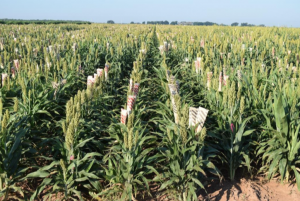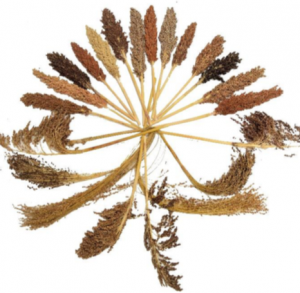INTERVIEW WITH DR. NIKHIL PATIL
Nikhil Patil is an accomplished biological scientist with 8+ years of laboratory and field research. He has experience in designing, conducting, and analyzing complex experiments in areas of molecular biology, plant breeding, and genomics. He is very proficient in communicating scientific data as evidenced by peer-reviewed publications and multiple presentations at national and international conferences. He is experienced in leading and managing a team for planning and executing production of quality-controlled products.
We were pleased to interview sir for our magazine. His dynamic contributions to the field of Biotechnology as a scientist and his experience as a student truly inspired us. Read his interview where he talks about his projects, journey and ideologies!
1. You are currently working as a post-doctoral research associate at Texas A&M University. What are your responsibilities there?
As a post-doctoral research associate I am working on multiple research projects mainly focusing on crop improvement. My main responsibility is to lead and manage these projects in a timely manner. This involves planning and executing experiments, collecting and analyzing data as well as reporting the results.
To be specific my job responsibilities are as follows
• DNA extraction and genotyping by sequencing of sorghum material.
• Statistical analysis of genotypic data including trait mapping.
• Planning and conducting field activities including planting, pollination, phenotyping and
harvesting sorghum materials utilized in the project.
• Inventory management including seed threshing, storage, packing for planting in subsequent
years.
• Conducting statistical analysis of phenotypic data for plant breeding selections and/or genetic
studies.
• Operating and trouble-shooting laboratory equipment and developing laboratory experimental
protocols related to sorghum breeding and genetics.
• Report results in scientific journals and grant proposal reports.
• Training graduate and undergraduate students in different aspects of research and laboratory
work.
2. You completed your masters in India and went to the US for a PhD. What is the difference between the two countries in terms of education, research and resources?
I consider myself fortunate to have received my education from both India and US. My Bachelors’ and Masters’ studies in India were instrumental in laying the foundation of my PhD studies in the US. A major difference I observed in the education system was that education in India is more focused on theoretical aspects of the subject whereas in the US the theory is also put into practice to give a better understanding. Also, education system in the US promotes independent learning as opposed to spoon feeding. While the coursework for a specific major is pretty much fixed in India there is more flexibility to choose subjects in the US. Internships and research projects are also an important part of the curriculum in the US and a lot of emphasis is placed on developing writing skills. Of course, education is costlier in the US compared to India.
US spends nearly 4 times (2.8 % GDP) more than India (0.7 % GDP) on research and development and this is reflected directly in the quality and quantity of research conducted and resources available. R&D in the US is funded by different sectors like the federal and state governments, academic institutions, nonprofit organizations and businesses whereas in India majority of the funding comes from the federal government and there is little contribution from the state government and private sector.
3. Covid-19 has affected the world drastically. Are you currently working on any projects directly/indirectly related to this pandemic?
Being a plant scientist specifically working on sorghum genetics I have not had the opportunity to be involved directly in any project related to Covid-19 so far. However, with the molecular biology experience that I have I look forward to working on any prospective projects related to the pandemic.
4. How important are bioinformatics skills to a biotechnologist in today’s technological world?
Today more than ever scientific inquiry and progress are driven by data and biotechnology is no exception. With technological advances made in almost every field of science, huge amount of data is generated every day. There is an even greater need for specialists who can decipher this data and make biological sense out of it. Just having domain knowledge is no more sufficient. Bioinformatic skills are becoming essential in fields of healthcare, pharma, agriculture etc. and there is a great demand for data scientists. Besides bioinformatic skills are highly transferable and offer flexibility to one’s career path.
5. Tell us about your research in plant breeding and genomics.
My research primarily focuses on genetic improvement of sorghum (jowar) using conventional breeding and modern genomic tools. Sorghum is a versatile crop grown for food, feed, fiber and fuel and has a potential to be an ideal “fail-safe” crop of future. However, it faces a number of production constraints including abiotic (drought, acidic and saline soils) and biotic (pests and diseases) stresses. While some of these challenges can in part be overcome by applying correct agronomic and management practices, long term solutions require crops to be enhanced at the genetic level.

My research involves screening and identifying sorghum plants having desirable traits (eg. disease resistance, lodging resistance), identifying the genes or genetic regions (QTL- quantitative trait locus) which control these traits, and breed these traits into crop varieties which lack these traits at a faster rate compared to traditional breeding methods.

My current project involves introducing genetic diversity from exotic sorghum into currently used elite commercial lines. For this we make crosses and back-crosses between exotic and elite lines and evaluate successive progenies for desirable agronomic traits. Incorporating exotic sorghum genome into elite lines widens the genetic diversity and potentially increase sorghum yields. This research is a small step towards achieving one of the United Nation’s Sustainable Development Goals, which aims to “end hunger, achieve food security and improved nutrition and promote sustainable agriculture by 2030”
6. You have also reviewed articles for referred journals. What do you believe qualifies as a good research paper?
Peer review is an important aspect of publishing research as it allows an unbiased scrutiny of one’s research and helps maintain high standards. While there are many factors that contribute to the quality of a research paper, few key elements distinguish a good research paper from a substandard one.
To start with, the research must be original in some way or be an extension of previously done work leading to new findings. The paper must provide sufficient background information about the research topic and a clear hypothesis. The experimental design/s chosen to investigate the hypothesis must be appropriate and described in detail for anyone to repeat. The results of the experiments must be stated and interpreted without any bias or extrapolation and any limitations of the research must be addressed as well. All sources of included information (references) must be cited appropriately. Finally, the manuscript must have a logical flow of ideas and be grammatically correct.
7. You’ve worked in the industry as well as academia. How different are these two domains?
Although for most of my career I have worked in academia, I also had a brief stint with the industry. One of the major difference I find is that in most cases academia is driven by quest for knowledge and industry is driven by economics. Academic research has more latitude to focus on basic research whereas research in industry is more applied and expected to bring revenue for the company. While academia produces a lot of publications (domain knowledge), industry leads with patents and products/ processes. The parameters of success in academia (grants, tenure, publications etc.) are different than that of industry (performance, sales etc.). The funding situation in industry is better compared to academia. The pace of academia is most of the times more stately as opposed to industry where timelines are stricter and pressure to deliver is higher. This is compensated by the fact that industry mostly pays better than academia.
I believe that both academia and industry complement each other where the ideas/knowledge generated by academia can be pivoted by industry for product/process development.
8. What kind of opportunities does USA provide to students of Biotechnology?
USA provides many opportunities for studying and working in the field of Biotechnology. Many universities offer Bachelor’s and Master’s degree programs in Biotechnology or Basic Science with focus on Biotechnology. These can be supplemented with internships in various Biotech based industries ranging from pharmaceuticals, agriculture, bioengineering etc. A degree in Biotechnology from USA enhances the chances of employment in USA. There are thousands of biotechnology-based companies in the USA with focus on different aspects so there is a tremendous scope for career advancement in this field.

